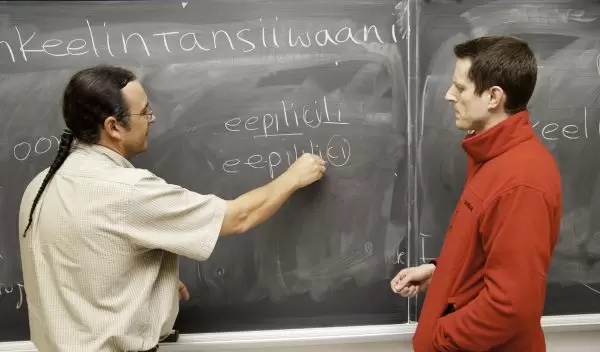
Breathing life back into language
The last fluent speakers of the Myaamia -- or Miami -- language passed away during the mid-20th century, around the same time Native American linguist Daryl Baldwin was born.
Today, thanks to the efforts of Baldwin, his family and other linguists and language preservationists, the Myaamia language is again taking its rightful place as a vibrant and visible symbol of identity and cultural pride for the Miami Tribe of Oklahoma.
Getting to this point wasn't easy. Baldwin developed an early interest in his heritage language when he found a Myaamia wordlist among his late grandfather's possessions. Without fluent speakers, recordings or helpful technology, his early efforts to learn more about the language relied on such wordlists, along with archived documents and academic writings on linguistics.
Baldwin's quest to learn Myaamia ultimately led to a master's degree in linguistics and a partnership with linguist David Costa. As Baldwin contributed his expertise and experiences to other tribes, the benefits to the research community ultimately went far beyond the Miami Tribe of Oklahoma. The resulting vibrant research program has garnered support from the National Science Foundation (NSF) Social, Behavioral and Economic Sciences Directorate (SBE). Just recently, Baldwin's work resulted in his being named one of the MacArthur Foundation's 2016 fellows, an award known as the "genius" grant.
"Our language and culture are central to our identity as Myaamia people. Our work to revitalize these important aspects of self over the last two decades has had a significant impact on our ability to recover important cultural knowledge and strengthen communal bonds," Baldwin says.
Archival language resources are vital to the linguistics archival model known as the Breath of Life, used to re-awaken Myaamia and other dormant Native American languages. Originating in California, the model integrates training in linguistics and utilization of archival resources, enabling tribal community members to research their heritage languages.
Baldwin is now set to lead the 2017 National Breath of Life Archival Institute for Indigenous Languages, a workshop supported by an award from NSF's Documenting Endangered Languages (DEL) program that focuses on helping endangered language communities find linguistic archival information.
The workshop, the fourth of its kind, will include representatives focused on 15 different languages. In total, more than 70 distinct Native American languages have been represented at these workshops, a number highlighting the tremendous diversity of the languages indigenous to the United States.
"The role of language and culture in shaping youth identity produces a level of interaction and communal presence that supports the kind of community development and personal integrity that is critical to a healthy future as a tribal community," Baldwin says. "The National Breath of Life Archival Institute brings individuals central to this work together to share and learn from each other."
The methodologies in Breath of Life projects pair language science training with direct access to archival collections at the National Anthropological Archives (NAA) and elsewhere. This combination provides a broad set of digital and accessible materials on Native American languages and equips participating citizen scientists with linguistic analysis skills they can apply when they return to their tribal communities.
In 2015, DEL funding allowed language scientists to digitize 1,500 historical pages from 14 different languages and make them accessible. Other digitization efforts funded at NAA resulted in a comprehensive set of materials for the Seneca language, including 3,928 publicly available pages, a direct result of Breath of Life research.
Baldwin's work is transformative, affecting how other indigenous communities conceptualize the role of language, and creating a new generation of Native American linguists through larger efforts around archival language research. He directs the Myaamia Center, located at Miami University in Ohio, which has created a series of courses on cultural and linguistic knowledge for tribal students attending the institution.
"The Myaamia Center at Miami University is unique in that it addresses important moral and just community work through interdisciplinary research, curricular development, teacher training, and youth intellectual development all aimed at reestablishing Myaamia language back into the proper cultural and communal context from which it evolved," Baldwin says.
He and his collaborators feel those courses play a crucial role in connecting students with their tribal identities, ultimately enhancing college retention rates.
Thus, Baldwin's research projects have the potential to impact scholarship in areas beyond linguistics, by demonstrating the important role Native American languages play as an essential component of well-being and identity for indigenous communities.


